[English] 日本語
 Yorodumi
Yorodumi- PDB-7d76: Cryo-EM structure of the beclomethasone-bound adhesion receptor G... -
+ Open data
Open data
- Basic information
Basic information
| Entry | Database: PDB / ID: 7d76 | ||||||
|---|---|---|---|---|---|---|---|
| Title | Cryo-EM structure of the beclomethasone-bound adhesion receptor GPR97-Go complex | ||||||
 Components Components |
| ||||||
 Keywords Keywords | MEMBRANE PROTEIN / GPCR / GPR97 / complex / adhesion G protein-coupled receptor | ||||||
| Function / homology |  Function and homology information Function and homology information: / mu-type opioid receptor binding / corticotropin-releasing hormone receptor 1 binding / negative regulation of non-canonical NF-kappaB signal transduction / vesicle docking involved in exocytosis / G protein-coupled dopamine receptor signaling pathway / regulation of heart contraction / parallel fiber to Purkinje cell synapse / postsynaptic modulation of chemical synaptic transmission / specific granule membrane ...: / mu-type opioid receptor binding / corticotropin-releasing hormone receptor 1 binding / negative regulation of non-canonical NF-kappaB signal transduction / vesicle docking involved in exocytosis / G protein-coupled dopamine receptor signaling pathway / regulation of heart contraction / parallel fiber to Purkinje cell synapse / postsynaptic modulation of chemical synaptic transmission / specific granule membrane / adenylate cyclase regulator activity / G protein-coupled serotonin receptor binding / adenylate cyclase-inhibiting serotonin receptor signaling pathway / regulation of cell migration / muscle contraction / B cell differentiation / locomotory behavior / negative regulation of insulin secretion / G protein-coupled receptor activity / GABA-ergic synapse / adenylate cyclase-modulating G protein-coupled receptor signaling pathway / G-protein beta/gamma-subunit complex binding / Olfactory Signaling Pathway / Activation of the phototransduction cascade / adenylate cyclase-activating G protein-coupled receptor signaling pathway / G beta:gamma signalling through PLC beta / Presynaptic function of Kainate receptors / Thromboxane signalling through TP receptor / G protein-coupled acetylcholine receptor signaling pathway / Activation of G protein gated Potassium channels / Inhibition of voltage gated Ca2+ channels via Gbeta/gamma subunits / G-protein activation / G beta:gamma signalling through CDC42 / Prostacyclin signalling through prostacyclin receptor / Glucagon signaling in metabolic regulation / G beta:gamma signalling through BTK / Synthesis, secretion, and inactivation of Glucagon-like Peptide-1 (GLP-1) / ADP signalling through P2Y purinoceptor 12 / photoreceptor disc membrane / Sensory perception of sweet, bitter, and umami (glutamate) taste / Glucagon-type ligand receptors / Adrenaline,noradrenaline inhibits insulin secretion / Vasopressin regulates renal water homeostasis via Aquaporins / Glucagon-like Peptide-1 (GLP1) regulates insulin secretion / G alpha (z) signalling events / ADP signalling through P2Y purinoceptor 1 / cellular response to catecholamine stimulus / ADORA2B mediated anti-inflammatory cytokines production / G beta:gamma signalling through PI3Kgamma / Cooperation of PDCL (PhLP1) and TRiC/CCT in G-protein beta folding / adenylate cyclase-activating dopamine receptor signaling pathway / GPER1 signaling / Inactivation, recovery and regulation of the phototransduction cascade / G-protein beta-subunit binding / cellular response to prostaglandin E stimulus / heterotrimeric G-protein complex / G alpha (12/13) signalling events / sensory perception of taste / extracellular vesicle / signaling receptor complex adaptor activity / Thrombin signalling through proteinase activated receptors (PARs) / retina development in camera-type eye / G protein activity / presynaptic membrane / cell body / GTPase binding / Ca2+ pathway / fibroblast proliferation / High laminar flow shear stress activates signaling by PIEZO1 and PECAM1:CDH5:KDR in endothelial cells / G alpha (i) signalling events / G alpha (s) signalling events / phospholipase C-activating G protein-coupled receptor signaling pathway / G alpha (q) signalling events / Hydrolases; Acting on acid anhydrides; Acting on GTP to facilitate cellular and subcellular movement / Ras protein signal transduction / postsynaptic membrane / cell surface receptor signaling pathway / Extra-nuclear estrogen signaling / cell population proliferation / G protein-coupled receptor signaling pathway / lysosomal membrane / GTPase activity / synapse / dendrite / Neutrophil degranulation / GTP binding / protein-containing complex binding / glutamatergic synapse / signal transduction / extracellular exosome / metal ion binding / membrane / plasma membrane / cytosol / cytoplasm Similarity search - Function | ||||||
| Biological species |  Homo sapiens (human) Homo sapiens (human) | ||||||
| Method | ELECTRON MICROSCOPY / single particle reconstruction / cryo EM / Resolution: 3.1 Å | ||||||
 Authors Authors | Ping, Y. / Mao, C. / Xiao, P. / Zhao, R. / Jiang, Y. / Yang, Z. / An, W. / Shen, D. / Yang, F. / Zhang, H. ...Ping, Y. / Mao, C. / Xiao, P. / Zhao, R. / Jiang, Y. / Yang, Z. / An, W. / Shen, D. / Yang, F. / Zhang, H. / Qu, C. / Shen, Q. / Tian, C. / Li, Z. / Li, S. / Wang, G. / Tao, X. / Wen, X. / Zhong, Y. / Yang, J. / Yi, F. / Yu, X. / Xu, E. / Zhang, Y. / Sun, J. | ||||||
 Citation Citation |  Journal: Nature / Year: 2021 Journal: Nature / Year: 2021Title: Structures of the glucocorticoid-bound adhesion receptor GPR97-G complex. Authors: Yu-Qi Ping / Chunyou Mao / Peng Xiao / Ru-Jia Zhao / Yi Jiang / Zhao Yang / Wen-Tao An / Dan-Dan Shen / Fan Yang / Huibing Zhang / Changxiu Qu / Qingya Shen / Caiping Tian / Zi-Jian Li / ...Authors: Yu-Qi Ping / Chunyou Mao / Peng Xiao / Ru-Jia Zhao / Yi Jiang / Zhao Yang / Wen-Tao An / Dan-Dan Shen / Fan Yang / Huibing Zhang / Changxiu Qu / Qingya Shen / Caiping Tian / Zi-Jian Li / Shaolong Li / Guang-Yu Wang / Xiaona Tao / Xin Wen / Ya-Ni Zhong / Jing Yang / Fan Yi / Xiao Yu / H Eric Xu / Yan Zhang / Jin-Peng Sun /  Abstract: Adhesion G-protein-coupled receptors (GPCRs) are a major family of GPCRs, but limited knowledge of their ligand regulation or structure is available. Here we report that glucocorticoid stress ...Adhesion G-protein-coupled receptors (GPCRs) are a major family of GPCRs, but limited knowledge of their ligand regulation or structure is available. Here we report that glucocorticoid stress hormones activate adhesion G-protein-coupled receptor G3 (ADGRG3; also known as GPR97), a prototypical adhesion GPCR. The cryo-electron microscopy structures of GPR97-G complexes bound to the anti-inflammatory drug beclomethasone or the steroid hormone cortisol revealed that glucocorticoids bind to a pocket within the transmembrane domain. The steroidal core of glucocorticoids is packed against the 'toggle switch' residue W, which senses the binding of a ligand and induces activation of the receptor. Active GPR97 uses a quaternary core and HLY motif to fasten the seven-transmembrane bundle and to mediate G protein coupling. The cytoplasmic side of GPR97 has an open cavity, where all three intracellular loops interact with the G protein, contributing to the high basal activity of GRP97. Palmitoylation at the cytosolic tail of the G protein was found to be essential for efficient engagement with GPR97 but is not observed in other solved GPCR complex structures. Our work provides a structural basis for ligand binding to the seven-transmembrane domain of an adhesion GPCR and subsequent G protein coupling. | ||||||
| History |
|
- Structure visualization
Structure visualization
| Movie |
 Movie viewer Movie viewer |
|---|---|
| Structure viewer | Molecule:  Molmil Molmil Jmol/JSmol Jmol/JSmol |
- Downloads & links
Downloads & links
- Download
Download
| PDBx/mmCIF format |  7d76.cif.gz 7d76.cif.gz | 178.7 KB | Display |  PDBx/mmCIF format PDBx/mmCIF format |
|---|---|---|---|---|
| PDB format |  pdb7d76.ent.gz pdb7d76.ent.gz | 133 KB | Display |  PDB format PDB format |
| PDBx/mmJSON format |  7d76.json.gz 7d76.json.gz | Tree view |  PDBx/mmJSON format PDBx/mmJSON format | |
| Others |  Other downloads Other downloads |
-Validation report
| Summary document |  7d76_validation.pdf.gz 7d76_validation.pdf.gz | 1.1 MB | Display |  wwPDB validaton report wwPDB validaton report |
|---|---|---|---|---|
| Full document |  7d76_full_validation.pdf.gz 7d76_full_validation.pdf.gz | 1.1 MB | Display | |
| Data in XML |  7d76_validation.xml.gz 7d76_validation.xml.gz | 35.6 KB | Display | |
| Data in CIF |  7d76_validation.cif.gz 7d76_validation.cif.gz | 52.4 KB | Display | |
| Arichive directory |  https://data.pdbj.org/pub/pdb/validation_reports/d7/7d76 https://data.pdbj.org/pub/pdb/validation_reports/d7/7d76 ftp://data.pdbj.org/pub/pdb/validation_reports/d7/7d76 ftp://data.pdbj.org/pub/pdb/validation_reports/d7/7d76 | HTTPS FTP |
-Related structure data
| Related structure data |  30602MC  7d77C M: map data used to model this data C: citing same article ( |
|---|---|
| Similar structure data |
- Links
Links
- Assembly
Assembly
| Deposited unit | 
|
|---|---|
| 1 |
|
- Components
Components
-Guanine nucleotide-binding protein ... , 3 types, 3 molecules ABG
| #1: Protein | Mass: 25286.922 Da / Num. of mol.: 1 Source method: isolated from a genetically manipulated source Source: (gene. exp.)  Homo sapiens (human) / Gene: GNAO1 / Cell (production host): sf9 / Production host: Homo sapiens (human) / Gene: GNAO1 / Cell (production host): sf9 / Production host:  |
|---|---|
| #2: Protein | Mass: 38245.801 Da / Num. of mol.: 1 Source method: isolated from a genetically manipulated source Source: (gene. exp.)  Homo sapiens (human) / Gene: GNB1 / Cell (production host): sf9 / Production host: Homo sapiens (human) / Gene: GNB1 / Cell (production host): sf9 / Production host:  |
| #3: Protein | Mass: 7861.143 Da / Num. of mol.: 1 Source method: isolated from a genetically manipulated source Source: (gene. exp.)  Homo sapiens (human) / Gene: GNG2 / Cell (production host): sf9 / Production host: Homo sapiens (human) / Gene: GNG2 / Cell (production host): sf9 / Production host:  |
-Protein , 1 types, 1 molecules R
| #4: Protein | Mass: 62767.098 Da / Num. of mol.: 1 Source method: isolated from a genetically manipulated source Source: (gene. exp.)  Homo sapiens (human) / Gene: ADGRG3 / Cell (production host): sf9 / Production host: Homo sapiens (human) / Gene: ADGRG3 / Cell (production host): sf9 / Production host:  |
|---|
-Non-polymers , 4 types, 7 molecules 

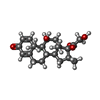




| #5: Chemical | | #6: Chemical | ChemComp-Y01 / | #7: Chemical | ChemComp-GXR / ( | #8: Chemical | |
|---|
-Details
| Has ligand of interest | Y |
|---|---|
| Has protein modification | Y |
-Experimental details
-Experiment
| Experiment | Method: ELECTRON MICROSCOPY |
|---|---|
| EM experiment | Aggregation state: PARTICLE / 3D reconstruction method: single particle reconstruction |
- Sample preparation
Sample preparation
| Component |
| ||||||||||||||||||||||||
|---|---|---|---|---|---|---|---|---|---|---|---|---|---|---|---|---|---|---|---|---|---|---|---|---|---|
| Source (natural) |
| ||||||||||||||||||||||||
| Source (recombinant) |
| ||||||||||||||||||||||||
| Buffer solution | pH: 7.5 | ||||||||||||||||||||||||
| Specimen | Conc.: 20 mg/ml / Embedding applied: NO / Shadowing applied: NO / Staining applied: NO / Vitrification applied: YES | ||||||||||||||||||||||||
| Specimen support | Grid material: GOLD / Grid mesh size: 200 divisions/in. / Grid type: Quantifoil | ||||||||||||||||||||||||
| Vitrification | Instrument: FEI VITROBOT MARK IV / Cryogen name: ETHANE |
- Electron microscopy imaging
Electron microscopy imaging
| Experimental equipment |  Model: Titan Krios / Image courtesy: FEI Company |
|---|---|
| Microscopy | Model: FEI TITAN KRIOS |
| Electron gun | Electron source:  FIELD EMISSION GUN / Accelerating voltage: 300 kV / Illumination mode: FLOOD BEAM FIELD EMISSION GUN / Accelerating voltage: 300 kV / Illumination mode: FLOOD BEAM |
| Electron lens | Mode: BRIGHT FIELD / Nominal magnification: 29000 X / Calibrated magnification: 49310 X / Cs: 2.7 mm |
| Specimen holder | Cryogen: NITROGEN / Specimen holder model: FEI TITAN KRIOS AUTOGRID HOLDER |
| Image recording | Electron dose: 62 e/Å2 / Detector mode: COUNTING / Film or detector model: GATAN K2 SUMMIT (4k x 4k) / Num. of real images: 2707 |
| Image scans | Movie frames/image: 40 |
- Processing
Processing
| Software | Name: PHENIX / Version: 1.16_3549: / Classification: refinement | ||||||||||||||||||||||||
|---|---|---|---|---|---|---|---|---|---|---|---|---|---|---|---|---|---|---|---|---|---|---|---|---|---|
| EM software |
| ||||||||||||||||||||||||
| CTF correction | Type: PHASE FLIPPING AND AMPLITUDE CORRECTION | ||||||||||||||||||||||||
| Particle selection | Num. of particles selected: 2026926 | ||||||||||||||||||||||||
| 3D reconstruction | Resolution: 3.1 Å / Resolution method: FSC 0.143 CUT-OFF / Num. of particles: 166116 / Symmetry type: POINT | ||||||||||||||||||||||||
| Atomic model building | PDB-ID: 6G79 Accession code: 6G79 / Source name: PDB / Type: experimental model | ||||||||||||||||||||||||
| Refine LS restraints |
|
 Movie
Movie Controller
Controller



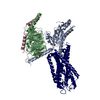
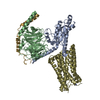

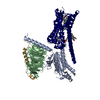
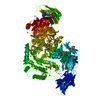
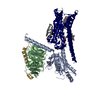
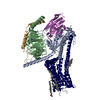

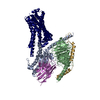

 PDBj
PDBj




























